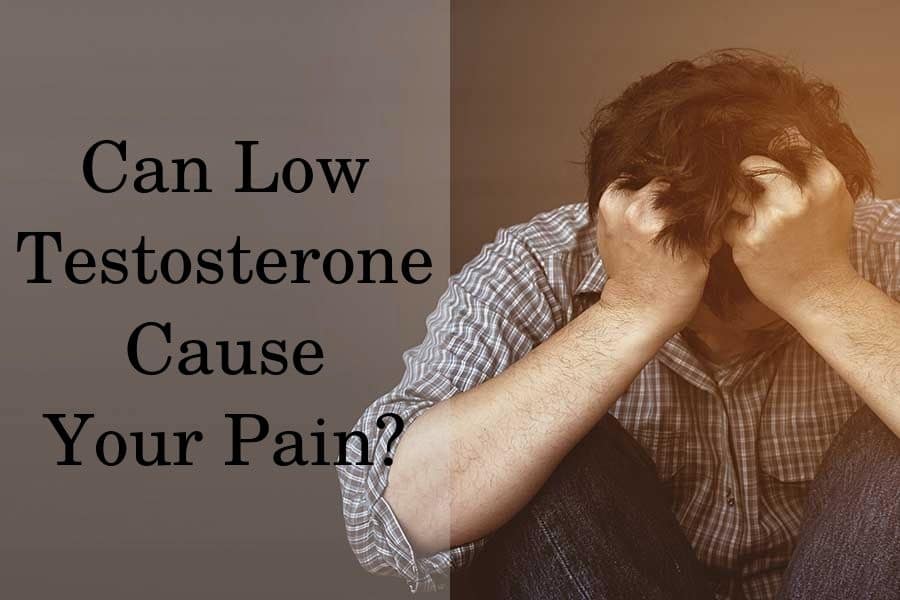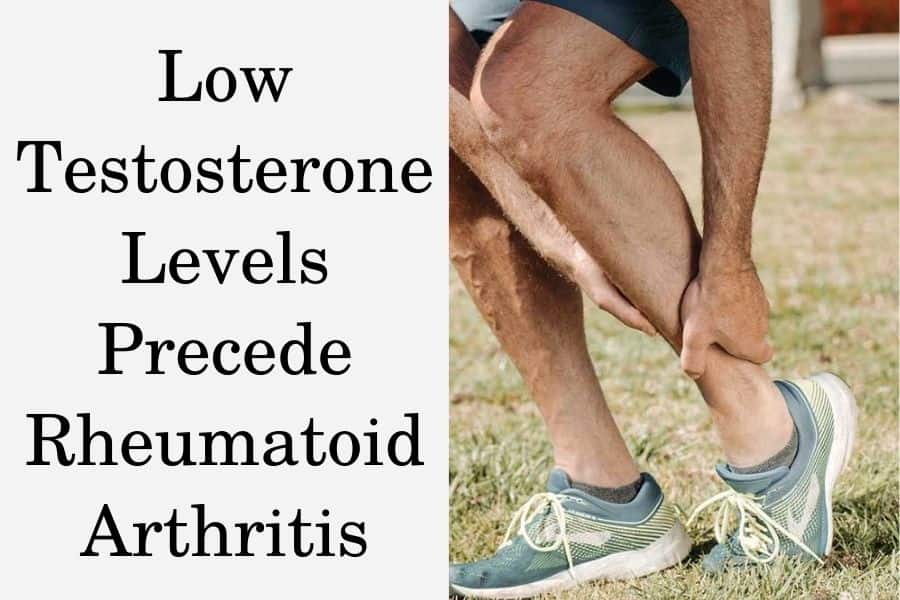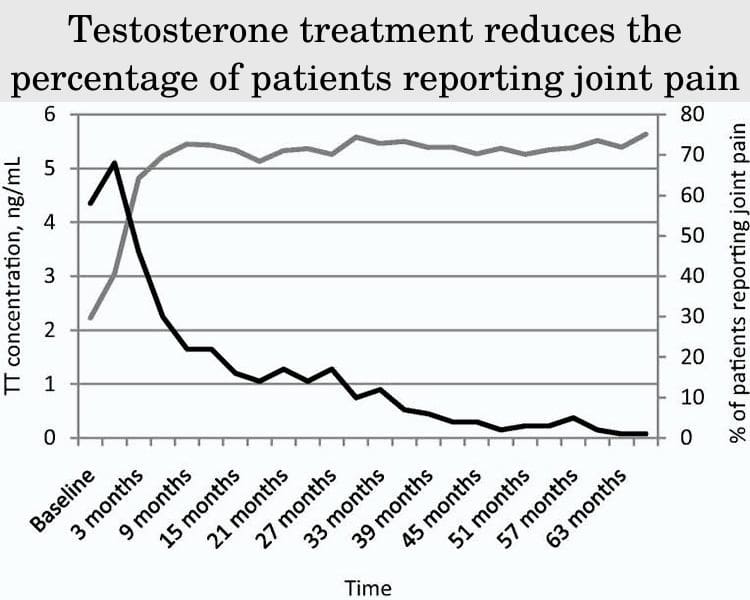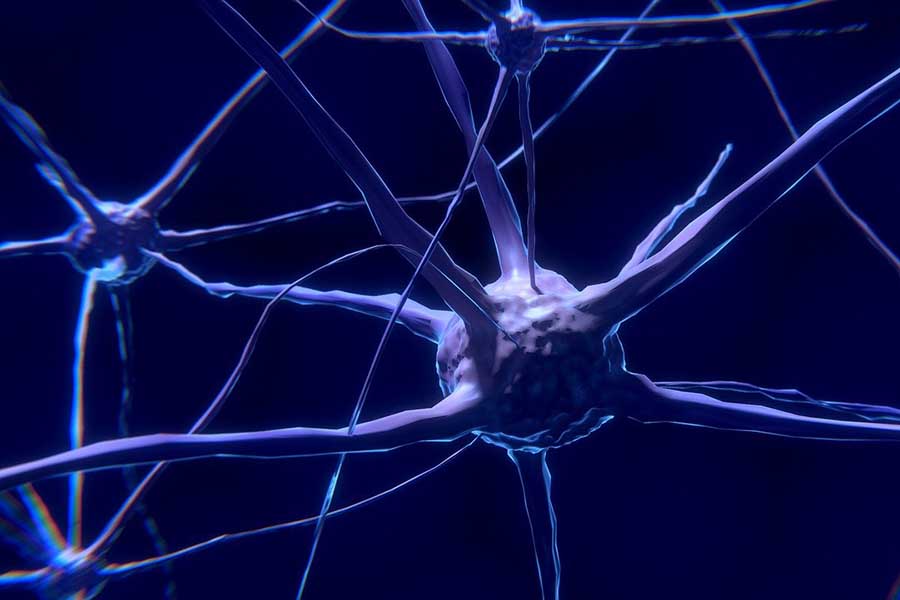There is a complex relationship between pain perception and the deficiency of the male sex hormone – testosterone.
New research suggests a link between testosterone and pain in certain conditions such as fibromyalgia, autoimmune arthritis, and chronic pain syndrome.
One of the theories is that the hormone regulates inflammation, and without sufficient T levels, inflammatory processes prevail, leading to pain and discomfort.
In fact, chronic inflammation is relatively common in men with low T since untreated hypogonadism leads to obesity. In turn, the excess fatty tissue starts producing an overabundance of proinflammatory cytokines, which cause systemic inflammation.
Restoring T levels in men with hypogonadism can help reduce body fat and inflammation. At the same time, recent evidence suggests that the hormone may also provide analgesic effects and reduce chronic pain symptoms.
Can low testosterone cause joint pain?
Studies suggest that there may be an association between low testosterone and joint pain, although the exact link between the two remains unclear.
Men with low T are more likely to experience an autoimmune condition called rheumatoid arthritis that affects the joints and often leads to disability.
Another form of autoimmune arthritis – psoriatic arthritis, also appears to be associated with low testosterone. What is more, the researchers report that the low T levels correlate with the severity of the condition.
Obesity may also be a possible link between low T and joint pain. Low T increases the buildup of fat and leads to obesity. In turn, studies report that obesity is a risk factor for joint pain due to osteoarthritis.
If you already have arthritis, weight gain due to low T can worsen the condition since being overweight increases the stress on your joints.
Obesity also increases inflammatory cytokine levels in the body and leads to systemic inflammation.
Being overweight further lowers T levels by converting it to estrogen via the enzyme aromatase found in adipose tissue. Thus people with obesity and joint pain often have unfavorable testosterone to estradiol ratio.
Preventing aromatization can restore some of the T levels and reduce the risk of symptoms due to high estrogen levels in men, such as gynecomastia.
How TRT helps with joint pain
Scientists suggested that the link may be the anti-inflammatory properties of testosterone, which are suppressed in men with hypogonadism and autoimmune arthritis.
A trial in older men with late-onset hypogonadism and joint problems reported that testosterone replacement therapy (TRT) led to benefits, including reduced symptoms of joint pain.
Testosterone therapy may help the proliferation of tenocytes, which are the cells that help make new tendon tissue. They also help with tendon repair in the case of tendon injury or tendinitis.
Furthermore, researchers reveal that testosterone helps increase tendon stiffness due to the stimulating effect of testosterone on collagen production. This effect may help improve the resilience of tendons against injuries.
In the case of injuries such as torn ACL (anterior cruciate ligaments) of the knee, testosterone treatment can prevent the loss of muscle mass, which often occurs due to immobilization during the recovery period. However, testosterone did not speed up the healing of the ligament itself.
Can low testosterone cause back and muscle pain?
Low testosterone has a negative effect on muscle mass. Without testosterone’s anabolic effects, you may lose both muscle mass and strength.
Furthermore, low T can lead to chronic fatigue and muscle weakness, which together make it difficult to perform even simple day-to-day tasks.
Yet, there is no evidence suggesting low T levels may increase the risk of muscle pain or muscle cramps in men.
How TRT helps with muscle and back pain
Testosterone therapy can help reduce symptoms of muscle and back pain in patients with hypogonadism. Restoring your normal serum T levels via testosterone therapy will also help increase your muscle mass and strength.
Also, women going through menopause may experience a rapid decline in both estrogen and testosterone levels, which can be accompanied by muscle aches and muscle cramps.
These perimenopausal symptoms occur because of the electrolyte changes accompanying the rapid shift of the reproductive hormones during this period.
Menopause often causes other types of pain as well, such as migraines. Interestingly, studies report that small doses of testosterone in perimenopausal women taken for 3 months relieve migraine symptoms in up to 92% of the participants.
*Yet, TRT is not officially approved for use in women and may be prescribed only off-label.
Can low testosterone cause nerve pain?
Preliminary research reports that testosterone may interact with how the nervous system processes pain. In animal experiments, birds treated with exogenous testosterone are more resistant to pain.
In another animal study, it was also suggested that the metabolites of testosterone, such as dihydrotestosterone (DHT), reduce neuropathic pain in diabetic rats.
On the other hand, a sudden drop in testosterone levels was shown to cause Parkinson’s-like tremors in castrated rats.
How TRT helps with nerve pain
Preliminary evidence suggests that testosterone may help reduce nerve cell damage and even facilitate nerve tissue healing. Unfortunately, there is no direct clinical evidence supporting these effects in humans.
So far, researchers have investigated the effects of testosterone treatment only in a few conditions related to neuropathy, such as fibromyalgia.
Fibromyalgia is a chronic condition that manifests with pain all over the body. Its cause is unknown, but scientists believe it’s related to changes in how your brain perceives and processes pain.
In male patients with fibromyalgia, taking testosterone for 28 days led to a significant decrease in muscle pain, stiffness, and fatigue, and increased libido during the treatment period.
What other pain can be caused by low T?
Low testosterone may also be linked to other types of pain, such as bone pain, migraines, and pelvic pain.
Hypogonadism can lead to bone loss and osteoporosis, leading to fractures and bone pain. If the osteoporosis affects the vertebrae, the condition may manifest with low back pain or deformations of the spine.
Low T levels may also be accompanied by testicular pain or pelvic pain. In this case, the reason for the pain, such as testicular injury or prostatitis, is also the underlying cause of the hypogonadism.
The testicular injury may occur due to varicocele, torsion, cryptorchidism, radiation, surgeries, trauma, or lack of stimulus from the pituitary gland (secondary hypopituitarism).
The most common cause of testicular pain and low T is varicocele, which occurs due to an enlargement of the veins within your scrotum (the skin pouch that holds your testicles).
Secondary hypopituitarism may occur due to various causes, including opioid medications for chronic pain. That’s because long-term use of opioids can lead to endocrine dysfunction, which also affects reproductive health in men.
What is more, prolonged opioid use often decreases the effectiveness of the medication, and pain persists despite increasing the dose of the opioids.
TRT in patients with hypogonadism on long-term opioid therapy led to a significant reduction of pain scores as soon as the 3rd month of treatment. The indexes continued to improve up to the 12th month of testosterone therapy.
Men with opioid-induced testosterone deficiency experienced reduced pain, improved body composition, increased libido, and better mood after 14 weeks of TRT.
How testosterone therapy helps with pain
Studies investigating the effect of TRT on men with low T and chronic pain report a significant reduction in symptoms within 6 months of therapy.
Testosterone also helps decrease body fat, which reduces the production of proinflammatory molecules from adipose tissue
If you have hypogonadism, other symptoms such as low libido, weight gain, and muscle weakness will be relieved even faster. Scientists report that men experience an increase in libido as soon as the 3rd week of therapy.
Furthermore, researchers have found that testosterone levels are positively correlated with activation in the middle frontal cortex of the human brain during electrical stimulation, resulting in a decrease in pain perception.
Other benefits to expect during the first month include improved mood, erections, and increased satisfaction from sex.
Fat loss and increased muscle mass occur 2-3 months after starting TRT, while after the 6th month, you may expect an increase in your bone mineral density and a reduced risk of bone fractures.
Testosterone may help with pain by reducing inflammation. Testosterone deficiency is associated with increased proinflammatory cytokines such as IL-1β, IL-6, and TNF-α while administering testosterone therapy increases anti-inflammatory cytokines (IL-10) and decreases the proinflammatory ones.
Get a free consultation with our medical expert for any questions about hormone replacement therapy





